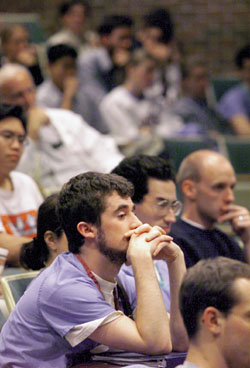
Eric Edwards listens to the lecture during the class – a joint class between VMS and Nursing School. (photo by Dana Johnson)
Dual Medical-Nursing class offered
Medical students and nursing students at Vanderbilt University Medical Center are joining forces in their training as part of a new and unique course.
The program, “Ecology of Health Care,” covers areas of medicine not normally covered by medical school or nursing school curriculums.
“The goal in the course is to heighten students awareness of the issues early in their training – issues such as communicating with patients, ethical and legal issues, practice management issues and other such issues that tend to fall by the wayside when you are teaching anatomy, biochemistry and microbiology,” said Dr. Deborah C. German, senior associate dean for Medical Education and co-director of the course.
The Ecology of Health Care course is jointly taught by faculty from the School of Nursing and the School of Medicine. The course development was a major collaborative effort by many faculty members in both schools, said co-director Dr. Gerald Gotterer.
“The idea started in the Dean’s (Dr. John Chapman, dean of the Medical School) mind many years ago. It was further developed by a core group of faculty about four or five years ago and then with some modification, it was implemented this year,” said Gotterer, senior associate dean for Faculty and Academic Administrative Affairs.
“Good patient care involves sensitivity to financing, to ethical and legal issues, to doctor-patient communications and to interdisciplinary care. The goal of this course is to better prepare the medical and nursing students to relate to the totality of patient care,” Gotterer said.
Gotterer said the idea to integrate medical students and nursing students was enthusiastically supported by Colleen Conway-Welch, dean of the School of Nursing, and Linda D. Norman, associate dean of the School of Nursing.
“I suspect that medical and nursing faculty would probably be in strong agreement that patient care benefits from interdisciplinary, collaborative care, but that medical and advanced practice nursing students have few joint opportunities to learn together how to deliver that care,” said Conway-Welch, Ph.D., R.N. “This course is an important step.”
Gotterer says it is important to include nurses in this program.
“Medicine is now practiced as a team and there needs to be better understanding of the perspectives of different members of those teams. The nurse practitioners in this course have a perspective very similar to that of practicing physicians, but nevertheless, they do represent part of the team that quite often medical students don’t understand. And similarly, nurses frequently don’t have an opportunity to talk to physicians at a peer level, so the opportunity to have better understanding of the mutual contributions of each to the care of patients is important as well as is achieving understanding of differences in perspective,” he said.
The Ecology of Health Care Course is unique in several ways: Nursing students and medical students participate together in the course; part of the course is offered on a web page on the Internet; and student evaluate each other.
“Having students evaluate and grade each other is a fairly new concept in medical education,” Gotterer said. “The intent of that is to get people attuned to being critiqued and critiquing their colleagues. This is something that physicians should do and don’t necessarily do very well. So we hope this course will help give students that experience.”
The two-year course is required for first- and second-year medical students. It’s an elective course for first- and second-year nursing students. There are 208 medical students and 56 nursing students currently enrolled.
This first year the course will be pass-fail, but ultimately it will become a graded course.
The course is divided into six units, each focusing on a phase of life including: Conception and Birth led by Dr. Frank H. Boehm, professor of Obstetrics and Gynecology and Dr. Ellen Wright Clayton, professor of Pediatrics and Law; Childhood led by Dr. Gerald B. Hickson, professor of Pediatrics and Dr. Clayton; Adolescence led by Dr. D. Catherine Fuchs, associate clinical professor of Psychiatry; Young Adulthood led by Dr. William O. Cooper, assistant professor of Pediatrics and Dr. G. Waldon Garriss, III., assistant professor of Medicine; Middle Age led by Dr. Allen B. Kaiser, professor of Medicine; and Late Adulthood led by Dr. Deborah W. Robin, assistant professor of Medicine.
First-year medical student, Airron Richardson, says the new course is great.
“I like it a lot,” Richardson said. “It exposes us to things that normally are not learned until we are out in the real world practicing medicine. It gives us a chance to be around practicing doctors and nurse practitioners and to ask them questions and find out more about medicine.
“It’s exciting to be at a school that is doing something so innovative. To be at a school that is flexible and willing to change with the times is neat. It makes you feel good to be at a school that is ahead of the rest.”
Francisco Guerra, in his first prespecialty year in VUSN, said the course is working well.
“The course challenges you to think outside the box. It provides a forum in the learning environment to explore difficult real world situations. There are no right and wrong answers,” Guerra said. “The course teaches you to expect difficulties and provides you with the opportunity to confront situations in which there will be no protocol or easy answers. In allotting students sufficient time in which to prepare their individual responses, a student’s opinion is challenged and allowed to evolve as they should.”













